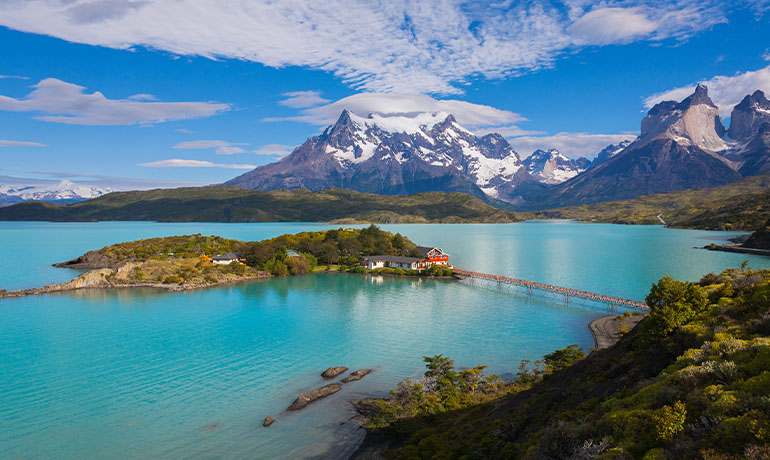Explore hiking paths sparsely trotted by adventurers before you, cruise uncharted waterways, and experience the vast beauty of Patagonia when you travel to Torres Del Paine National Park. In this park, nature and wildlife rule, and tourists are mere observers of the wonders that nature has created. Iconic mountain peaks, exotic animals only found here, and unpredictable weather keeps you guessing every day whether you’ll be setting off on an exciting hike or enjoying views safely inside luxury accommodations.
The unusual weather in Torres Del Paine National Park adds to its charm. However, following its historical weather trends, you will know when is the best time to visit Torres Del Paine National Park to experience what makes this one of the most captivating regions in the world.
Table of Contents
When Is The Best Time To Visit Torres Del Paine?

Planning a trip to Patagonia and curious about the best time to visit Torres del Paine National Park? You should know that this region of the Earth has highly unpredictable weather, and it is common to experience multiple seasons within one day! By morning you can have mild temperatures perfect for going on a hike while encountering windy snowstorms mid-day.
So when should you visit Torres del Paine? With the proper preparation, every season can be an excellent time to visit the national park. However, it depends on what you’re hoping to experience, and our Marchay members have access to resources and experts to help plan the ideal trip.
Torres del Paine is located in the Southern Hemisphere, so its seasons are reversed compared to travelers coming from the Northern Hemisphere.
Summer (December-February) is the high season for visiting Torres del Paine and has the warmest weather throughout the year. Tourism in the park is most active, with many hotels, hostels, campsite accommodation experiences, guided tours, excursions, and more! Due to its popularity, its hiking trails are most crowded. Additionally, it’s the windiest time of the year.
Spring (September to November) and Fall (March to May) are some of the best times to visit Torres Del Paine. It reveals its true colors through springtime blossoms and fall foliage. And since they’re the shoulder seasons, the crowds are fewer to immerse yourself more in nature.
When Is The Worst Time To Visit Torres Del Paine?
Nature is unpredictable, especially in remote regions of the world such as Torres Del Paine National Park. Arriving at the park is an adventure on its own, so you’d hope to be able to experience everything you’re hoping for to make the trip worthwhile. So, while Torres del Paine is open all year-round, certain times of year are more preferred than others to visit.
Torres del Paine is constantly changing, both in nature and in activities available throughout the park. Therefore, the worst time to visit Torres Del Paine is based on being able to experience what you’re expecting.
The low season for visiting Torres Del Paine National Park is during the winter. The winter season lasts from June to August, a period when it averages the lowest temperatures and highest precipitation. So, you can look forward to freezing temperatures dropping to the low 30s Fahrenheit and snow-covered trails.
Many hotels and tour operators close during the winter due to unexpected nature conditions and fewer tourists. However, some may prefer this time of year to witness wildlife and enjoy trails free of other travelers.
Visiting Torres Del Paine In The Spring
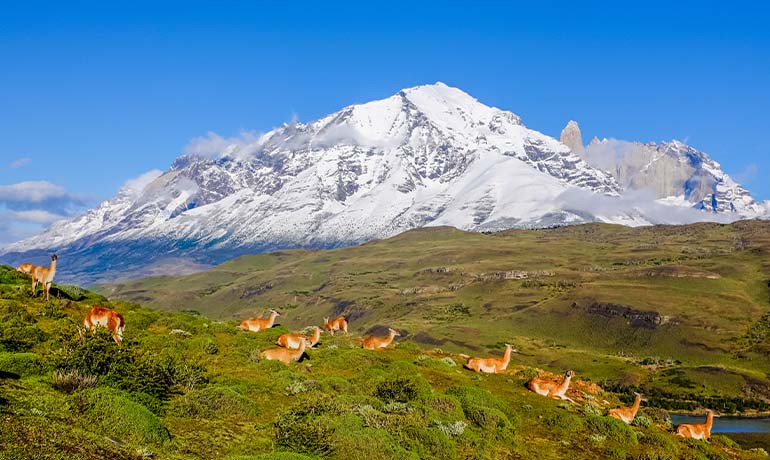
Springtime in Torres Del Paine ushers in a new makeover for the park. The vast snowy fields and frozen terrain rebirth into a colorful display of freshly bloomed wildflowers and wildlife stirring after the long, cold winter. The spring months between September to November are one of the best times to visit Torres Del Paine.
As the snow melts and the days get longer, seasonal hotels and tours in Torres del Paine begin to reopen and welcome newcomers to the exotic wilderness. While the weather is still highly unpredictable, spring typically averages in the mid-40s Fahrenheit during the day while still dropping to freezing temperatures at night. So, while you’ll still need layers, it’s the perfect time to get out and begin exploring the park’s attractions.
Hike through the lush fields of Ascencio Valley filled with vibrant purples, yellows, reds, greens, and a spectrum of other wildflower colors. Also, take advantage of this season just before other hikers arrive to have the W Trek and other popular routes to yourself. While trekking the park, you’ll have the best chance at seeing wildlife during the spring, thanks to the mating season for many animals and birds returning after their winter escape.
Visiting Torres Del Paine In The Summer
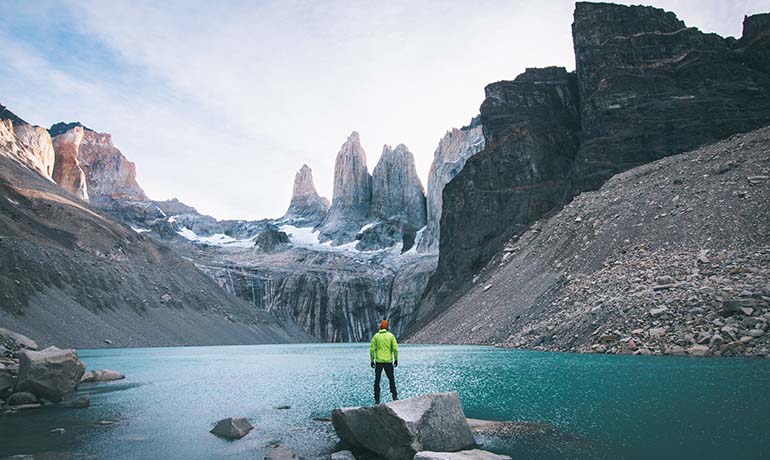
If you’re looking for beautiful days to witness all the natural wonders of Torres del Paine National Park, consider visiting during the summer. Summer is the most popular time to visit the national park since the days are long and you’ll have the best chance at seeing its iconic views.
The summer months in Torres del Paine are December to February. It coincides with the holiday travel season in the Northern Hemisphere, and many adventurous travelers plan their escape to the remote wilderness of the park when the weather is ideal. You can expect temperatures averaging in the low- to mid-50s Fahrenheit and upwards of 17-hours of daylight! Although the weather trends are favorable to spending time outdoors, pack accordingly because you’ll feel the rush of the strong winds, and locations like Gardner Pass have snow all year-round.
Take advantage of the extended days by enjoying sunrise views of the park as early as 5:30 am. It’s one of the best times to attempt the O circuit multi-day hike and stop by the numerous refugios. Also, backpacking the Carretera Austral route to see some of the best sights.
Visiting Torres Del Paine In The Fall
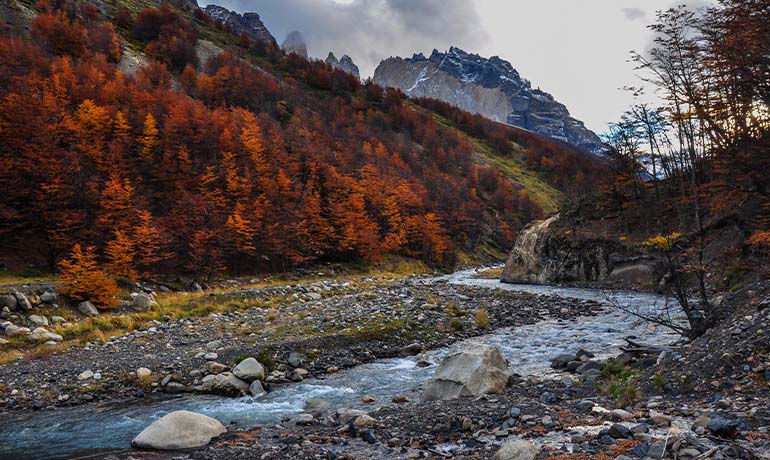
The fall shoulder months of March to May are an exciting time to visit Torres del Paine National Park. Its transitional weather from the summer to the winter creates unique weather patterns capable of rendering unexpected occurrences even hours apart. But for those who thrive in the unexpected — something to get accustomed to while visiting the park — Fall can be one of the best times to visit.
With the busy tourist rush leaving at the end of March, the crowds thin out during the fall. You’ll feel like it’s just you and nature — soaking up the last bit of the long daylight hours that get shorter every day; hiking the trails worn by the summer rush that will soon be covered in snow during the upcoming months, and the infamous wind that settles just enough to feel the stillness of the park.
Fall is one of the best times to experience the natural charm of Torres Del Paine National Park. Contrasting with the vibrant Spring colors, you’ll witness the fall foliage of reds, oranges, and golden tones while horseback riding through French Valley. Also, the still water surfaces at landmarks like Lake Pehoe reveal a mirror reflection of Los Cuernos Del Paine in the backdrop, one of the iconic views of the park.
Visiting Torres Del Paine In The Winter
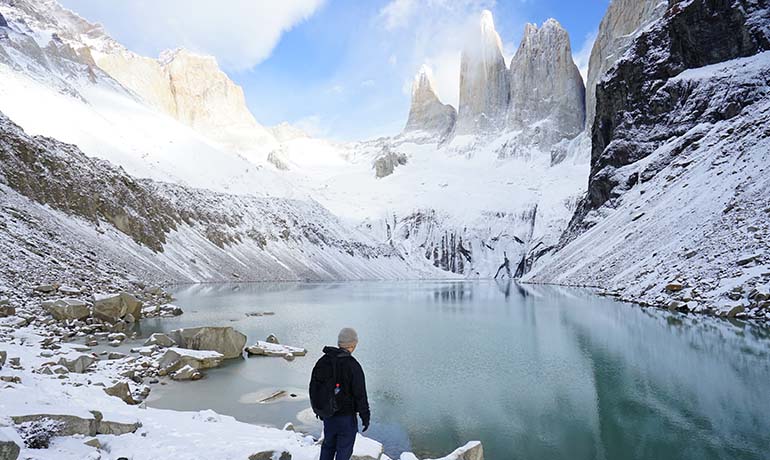
The extreme weather that Patagonia is known for becomes evident during the winter months. With temperatures hovering around a chilling 30-40-degrees Fahrenheit, it’s important to pack wisely to maximize the best time to experience pure nature in Torres Del Paine.
The Winter season lasts from June to August and is the low season in Torres Del Paine National Park. But with less tourist traffic, it gives the wildlife a chance to reclaim their territory and reveal themselves to the scarce visitors venturing into the park during this season. Keep your cameras handy because it’s an excellent time for spotting mountain lions, puma, guanacos, deer, and more.
With only approximately eight hours of daylight, you’ll have time for just a few activities every day before the freezing nighttime arrives. Use your time wisely by hiking the Base of the Towers, riding fat bikes around Blue Lagoon, or exploring waterways like Lago Grey and Laguna Amarga. Wintertime cruises in Torres del Paine National Park let you witness the rich blue tones of the massive Grey Glacier and other waterfront views.
Keep in mind that many hotels, hiking trails, and tours are closed during the winter season.
Attractions & Things to Do In Torres Del Paine
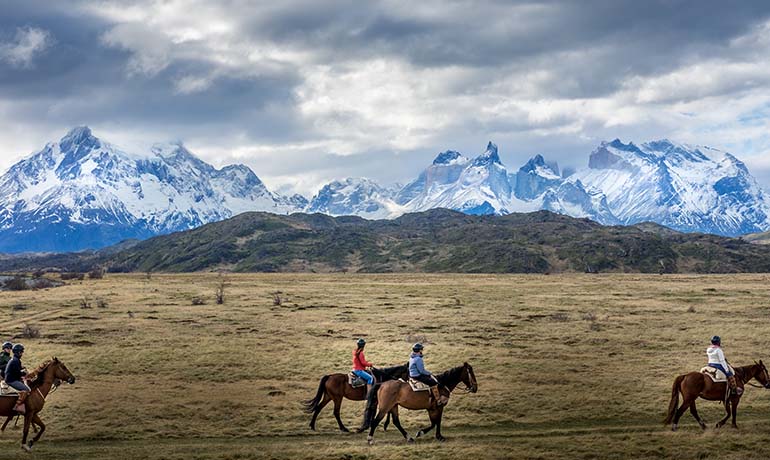
#1. Hike To The Base Of The Torres
Pick the best day to attempt the challenging Base of the Torres hike near Puerto Natales. But once you reach the end of the eight-hour trek, you’ll be greeted with one of the most famous landmarks in the park.
#2. Take In The Views Of Salto Grande
The glacier-blue waters rushing over the ledge from the Paine River form the alluring Salto Grande Waterfall. It’s a popular natural attraction accessible with a 1.2-mile hike to see the falls.
#3. Hike To Mirador Del Cóndor
Whether searching for Peru’s national bird or seeking one of the best views in Torres del Paine National Park, Mirador Del Cóndor is a hiking trail that attracts everyone. Ascending to the highest point overlooking Colca Canyon, you’ll have a chance to spot the large Andean Condor, whose 10-ft wingspan causes shadows over the world’s deepest canyon.
#4. Sail Across Lago Pehoé
Enjoy views of the snow-capped Paine Massif mountains while sailing on a catamaran boat across Lago Pehoé. Peer into the turquoise waters to see reflections of the surrounding scenery or set your gaze to the grassy lakeshore to spot the elusive guanacos.
#5. Kayak Through The Waterways Of Grey Glacier
Views of Grey Glacier as seen from a kayak is the best way to appreciate its massive 30-meter height. Recent years have experienced melting and mass-loss for the glacier, so it’s best to put it on your itinerary while it’s still here.
#6. Trek Through French Valley
French Valley, or Valle de Frances, is a culmination of Patagonia’s diverse landscape. Hiking treks through the valley alongside the French River provide views eclipsed by Glacier Frances rising above Nordenskjold Lake.
#7. Visit Laguna Azul
The rich blue hues of Laguna Azul are simply captured by the name, which translates to ‘Blue Lagoon.’ This large, scenic lake sits in Laguna Azul Valley and offers hiking treks through the wetlands, bird-watching, and accommodations framing the spectacular views.
#8. Hike To Mirador Cuernos
Known as ‘the horns,’ Mirador Cuernos provides the best view of Cordeilla Paine Mountain’s iconic peaks. Plan a day trek to the viewpoint, whose pleasant hike takes you past lakes and through valleys before arriving at the sight perched above Lake Nordenskjold.
#9. Go Guanaco Spotting
The small deer-like guanaco animals are abundant in Torres Del Paine National Park, although considered extinct in terms of the global population. You can find these animals living in herds in the park’s grasslands, forests, and lakeshores.
#10. Ride Horseback Through Torres Del Paine National Park
Feel the rush of the wind on your face while galloping through Torres Del Paine National Park on horseback. Guided tours lead you through scenic regions like French Valley to fully immerse you in nature with stunning views and adventure.
The Bottom Line
From the peaks of its snow-capped mountains to canyons carved out by millions of years of glacier activity, Torres del Paine National Park is full of natural wonders waiting to be discovered. Sign up for a Marchay membership to embark on a journey through this remote wilderness all year long, encountering new experiences depending on the season you want to visit.
Torres Del Paine National Park keeps visitors in awe with its ever changing weather patterns that add to the park’s wonder. It’s a place where you can experience all seasons within 24 hours or get lucky and have clear days to truly admire its towering peaks.
Determine what you want to see and experience in Torres Del Paine and plan your trip accordingly to make the most of your trip.
Frequently Asked Questions
How cold does it get in Torres Del Paine?
When traveling to Torres Del Paine National Park, one of the best travel tips is to dress in layers because the weather is highly unpredictable. With its proximity to Antarctica, It’s a place where you can experience snow all year round, depending on your elevation or location. However, the coldest temperatures always arrive in the winter months of June, July, and August.
The average temperature in the winter has a high of 41°F (5°C) and gets as cold as 27°F (-3°C). July is the coldest month in Torres Del Paine National Park when you’re likely to have temperatures closer to freezing levels.
Several factors contribute to the cold temperatures during the park’s winter. The forceful wind gusts reaching speeds of up to 110-miles-per-hour can add significant wind chill. Also, shorter days in the winter season mean less sun.
How busy is Torres Del Paine?
The Torres Del Paine National Park is largely a remote wilderness at the southern tip of Chile. And although it’s one of the most visited national parks in the country, it’s far from having the large crowds you’d typically think of for a top destination.
Every year, Torres Del Paine National Park receives about 300,000 visitors. The busiest time to visit the park is between December and February during the summer season. This peak season has longer days and the warmest weather for enjoying outdoor hikes and cruises. It’s when you’re likely to encounter other hikers on popular routes like the W Trek. Although summer is the most popular time to visit, the remote nature of the park still makes it relatively empty compared to other national parks around the world.
What is the best month to visit Chile?
Chile is a country located in South America and a popular travel destination. From its major cities like the capital Santiago to natural attractions like the Atacama Desert or remote Chilean Patagonia region, there are lots of things to do and see during a trip to Chile. Base yourself in Punta Arenas or Puerto Natales for easy access to Torres del Paine National Park. Take a day trip to other parts of the country during your visit to experience its diversity of nature, culture, and history.
Since Chile is located in the southern hemisphere, it experiences its warmest months from December to February and the coldest time is from June to August. The best time to visit Chile is January, the warmest month in places like Torres Del Paine National Park.
